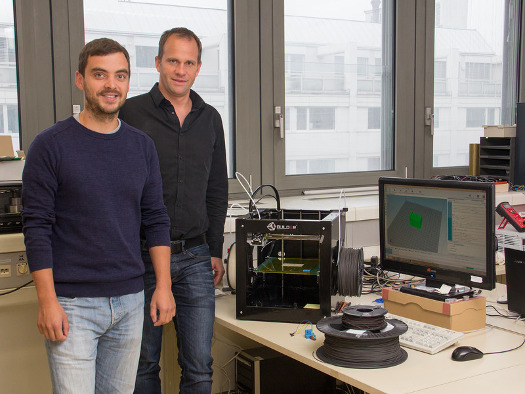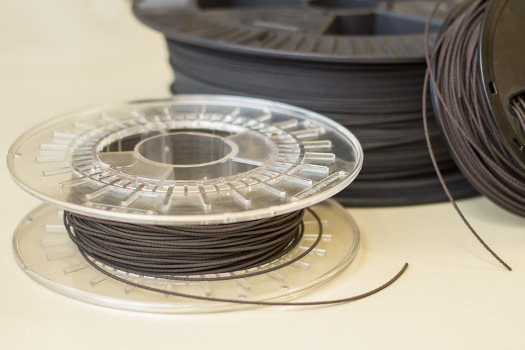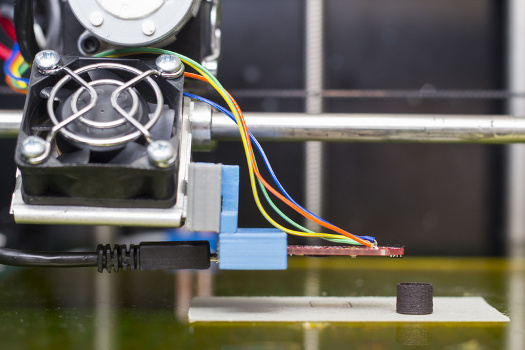 |
| November 08, 2016 | Volume 12 Issue 42 |
Designfax weekly eMagazine
Archives
Partners
Manufacturing Center
Product Spotlight
Modern Applications News
Metalworking Ideas For
Today's Job Shops
Tooling and Production
Strategies for large
metalworking plants
Precisely tuned magnets made with 3D printer

Christian Huber (left) and Dieter Süss at the TU Wien are making powerful, tuned magnets using 3D printing.
In the past few decades, we've witnessed the evolution of materials used in 3D printing, marveling at the use of plastics and metal, composites, carbon fiber, and more. Now there's something even more "attractive."
Today, manufacturing strong magnets is no problem from a technical perspective. It is, however, difficult to produce a permanent magnet with a magnetic field of a specific pre-determined shape. That is, until now, thanks to a new solution devised at the Technische Universitat Wien (TU Wien), a university in Vienna, Austria. There, for the first time, researchers have figured out how to produce permanent magnets using a 3D printer. This allows magnets to be made in complex forms with precisely customized magnetic fields that are required, for example, in magnetic sensors.
"The strength of a magnetic field is not the only factor," says Dieter Süss, head of the Christian-Doppler Advanced Magnetic Sensing and Materials laboratory at TU Wien. "We often require special magnetic fields, with field lines arranged in a very specific way -- such as a magnetic field that is relatively constant in one direction, but which varies in strength in another direction."
In order to meet such requirements, magnets must be produced with a sophisticated geometric form. "A magnet can be designed on a computer, adjusting its shape until all requirements for its magnetic field are met," explains Christian Huber, a doctoral student in Süss' team.
But once you have the desired geometric shape, how do you go about implementing the design? The injection molding process is one solution, but this requires the creation of a mold, which is time consuming and expensive, rendering this method barely worthwhile for producing small quantities.
The secret sauce: Tiny magnetic particles in the polymer matrix
Now, there is a much simpler method: the first-ever 3D printer that can be used to produce magnetic materials, created at TU Wien.

Pre-magnetic materials are bonded with a polymer to create filaments.
3D printers that generate plastic structures have existed for decades, and the magnet printer functions in much the same way. The difference is that the magnet printer uses specially produced filaments of magnetic micro granulate. Each filament is held together by a polymer binding material. The printer heats the material and applies it point by point in the desired locations using a nozzle. The result is a three-dimensional object composed of roughly 90 percent magnetic material and 10 percent plastic.
The end product is not yet magnetic, however, because the granulate is deposited in an unmagnetized state. At the very end of the process, the finished piece is exposed to a strong external magnetic field, converting it into a permanent magnet.

This magnetic cup-like shape was created using a 3D printer. It features tailor-made magnetic properties influenced by the type and density of the material and the final design shape.
"This method allows us to process various magnetic materials, such as the exceptionally strong neodymium iron boron magnets," explains Süss. "Magnet designs created using a computer can now be quickly and precisely implemented -- at a size ranging from just a few centimeters through to decimeters, with an accuracy of well under a single millimeter."
Not only is this new process fast and cost effective, it also opens up new possibilities that would be inconceivable with other techniques. In one example, you can use different materials within a single magnet to create a smooth transition between strong and weak magnetism.
"Now we will test the limits of how far we can go," says Süss. "But for now it is certain that 3D printing brings something to magnet design which we could previously only dream of."
Source: TU Wien
CITATION: "3D print of polymer bonded rare-earth magnets, and 3D magnetic field scanning with an end-user 3D printer." Huber et al., Applied Physics Letters (109, 16); DOI: 10.1063/1.4964856.
Published November 2016
Rate this article
View our terms of use and privacy policy
